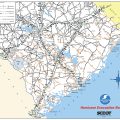
The forecasts for the 2024 hurricane season are coming in fast and furious, with the annual Colorado State University forecast from lead forecaster Dr. Phil Klotzbach first out of the chute. The numbers are staggering! Twenty-three named storms, 11 hurricanes and five major hurricanes.
In an average season, we would expect 14 named storms, seven hurricanes and three major hurricanes. Dr. Klotzbach and his team are pointing to two main factors behind the active forecast. The waters in the Tropical Atlantic are much warmer than normal this early, and a shift from the normally tropical inhibiting El Nino pattern to a more conducive La Nina episode during the peak months of August, September and October. This upcoming year, there are forecast probabilities for a landfall, or landfalls. Dr. Klotzbach believes there is a 62 percent chance that a major hurricane will make landfall somewhere along the coast of the United States. The long-term average is 43 percent.
When it comes to the East Coast, from Maine to Florida, the probability is 34 percent, which is much higher than the long-term average of 21 percent.
As you know, we have been so very lucky, and have not experienced a major hurricane landfall since Hurricane Hugo in September 1989. When you look at the return average of a major hurricane every 22 years, the phrase “we are due” is not a stretch.
So, what can we do to make sure we are prepared for whatever the tropical season has in store? Preparation is key.
It’s important to have a plan. First thing is to know your risks. Are you in a flood zone? Are you susceptible to storm surge, flooding from heavy rainfall, strong winds, tornadoes or even rip currents? We know in the Charleston area we flood quite a bit, even on a sunny day due to higher- than-normal tides.
Make sure you have a kit prepared. Ready.gov is a great resource. Here is what should be included:
- Water (one gallon per person per day for several days, for drinking and sanitation)
- Food (at least a several-day supply of non-perishable food)
- Battery-powered or hand crank radio and a NOAA Weather Radio with tone alert
- Flashlight
- First aid kit
- Extra batteries
- Whistle (to signal for help)
- Dust mask (to help filter contaminated air)
- Plastic sheeting and duct tape (to shelter in place)
- Moist towelettes, garbage bags and plastic ties (for personal sanitation)
- Wrench or pliers (to turn off utilities)
- Manual can opener (for food)
- Local maps
- Cell phone with chargers and a backup battery
You will also want to video or take photographs of your property and belongings, just in case you need to show your insurance company. It’s also a good idea to check with your insurer first, to make sure you have everything in place just in case you are impacted by a storm.
Finally, know where you are going to go if you do evacuate, and make sure you communicate that to family and friends. This will help to eliminate possible confusion after a storm has come and gone.
By Rob Fowler, Chief Meteorologist, News 2




Leave a Reply